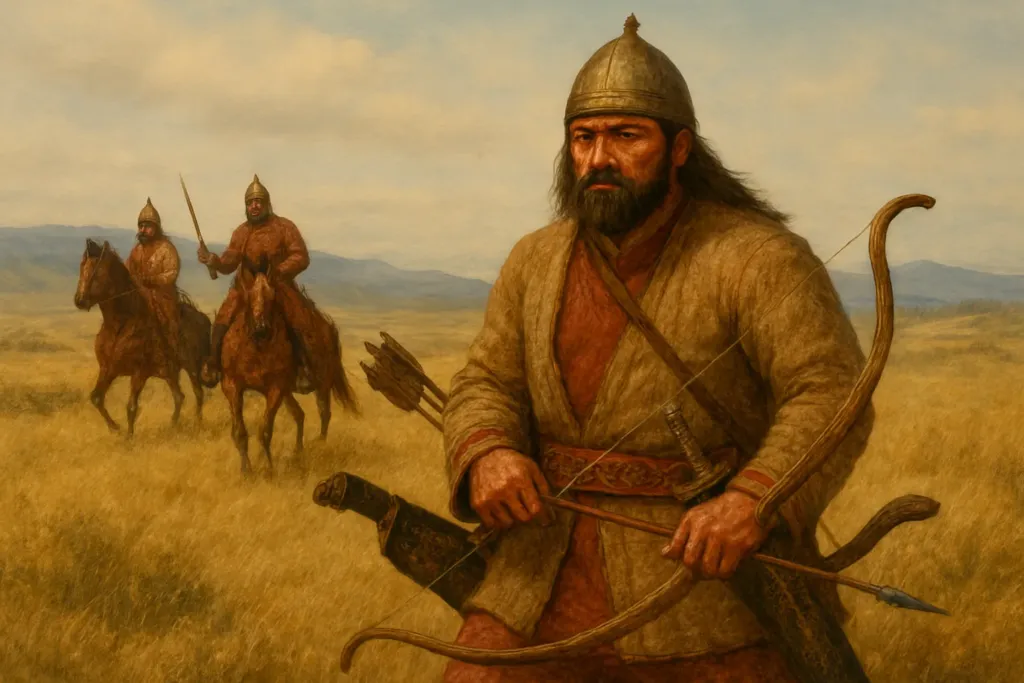The Scythians were an ancient Iranic‑speaking nomadic people and confederations of the Eurasian steppe. Their language (Eastern Iranian) lacked a native script; it survives in names, toponyms, and loans. Religion centered on fire and ancestor cults, with deities akin to Tabiti (hearth), Papaios (sky), Api (earth), Argimpasa (fertility), and seers called Enarei. Traits included martial discipline, mobility, hospitality to allies, and severity toward foes. Aggression reflected a steppe war culture; within communities, seniority and agreements governed life. Wine feasts were known via Greek ties; cleansing rituals used aromatic smoke (hemp) as described by classical authors. Popular activities featured mounted archery, wrestling, and equestrian games.
History
8th–7th c. BCE: formation in the North Pontic steppe after movements from the Caucasus/Urals; displacement of Cimmerians. 7th–6th c.: campaigns into the Near East, mercenary service, shifting alliances. 5th–4th c.: “Great Scythia” from the Danube to the Don, trade with Greek poleis, treasures of “Scythian gold.” Late 4th–3rd c.: Sarmatian pressure, retreat and contraction; enclaves persist (Tauric/Caucasian Scythia, Scythia Minor). 1st c. BCE–1st c. CE: local kingdoms around Crimea and the lower Dnieper, then absorption into Sarmatian‑Alan and early Slavic matrices. Legacy endures in kurgans, animal‑style art, and cavalry tactics.
Name
“Scythians” is the Greek exonym; classical writers also transmit the self‑name “Skolotoi,” while “Saka” labels eastern Iranic kin groups. The terms cover a cultural‑linguistic horizon rather than a single homogeneous nation.
Occupations
Historically: mobile pastoralism (horses, sheep, goats, cattle), horse breeding, hunting, raiding and guarding trade routes, mercenary warfare, caravan trade, crafts (leatherworking, metalwork, wood/bone), and composite bow‑making. Semi‑settled groups farmed millet, wheat, and barley along the forest‑steppe. Today: as a people they no longer exist; their “work” survives as archaeological heritage, scholarship, living‑history reenactment, and tourism.
Physical description
Skeletal and textual evidence shows steppe Europoid variability across regions; medium stature, rider’s build, moustaches/beards among elites. Individual variation was wide; racial typologies are outdated and oversimplify ancient population complexity.
Habitat
Historically: steppe and forest‑steppe from the lower Danube and Bug across the North Pontic, the Don and Volga to the Caspian fringes and the Urals, with incursions into the Caucasus, Crimea, Dobruja, and the Near East. Modern countries preserving sites include Ukraine, Russia, Kazakhstan, Romania, Moldova, Bulgaria, Georgia, Azerbaijan, and Iran. Continents: Europe and Asia.
Wars and conflicts
Key rivals and neighbors: Cimmerians (early), Persians (Darius I’s campaign), Thracians, Siraces, Sarmatians (conquest), and Greek poleis (both partners and foes). Internal dynastic strife appears in classical tales. Tactics: mounted archery, feigned retreats, sudden raids, close combat with akinakes short swords.
Population
No precise counts exist; in antiquity they comprised dozens of tribes and alliances totaling, at peaks, hundreds of thousands of nomads plus dependent sedentary groups. Trend: expansion by the 5th–4th c. BCE, contraction from the late 4th c. due to Sarmatian pressure, climate shifts, and trade route changes; by the 1st–2nd c. CE they vanish as a political entity. Today the Scythians as a people are extinct; their legacy lives in archaeology and neighboring cultures.
Traditions, rituals, festivals
Kurgan burials with “royal” mounds, horse sacrifices, and funeral feasts. Hearth cults, sword oaths, and smoke‑cleansing rites. No written festival calendar survives; nomadic cycles, warfare, and herd movements set the year’s rhythm.
Myths and legends
The forefather Targitaos and heaven‑sent golden gifts; Heracles’ union with a serpent‑woman birthing the Skolotoi; deities Tabiti, Papaios, Argimpasa, Api. Tales of the sage Anacharsis, the prince Scyles, motifs of warrior women and Enarei seers.
Notability
Figures: Idanthyrsus (defied Darius I), Ateas (Danubian unifier), Skilur (Crimean ruler), Anacharsis (Scythian sage), Tomyris (Massagetae queen within the broader “Scythian” sphere). Arts: animal‑style masterpieces — “Scythian gold” — headline museum halls. In literature and art: from Herodotus to Alexander Blok’s poem “The Scythians”; in film and reenactment, the mounted archer archetype endures.
Food
Meats (horse, mutton, beef), dairy (including mare’s milk and sour drinks), game; among sedentary groups — millet, grains, vegetables. Cooking in cauldrons and hides as classical writers recount; smoking and drying; fish in coastal zones. Wine featured in feasts and exchange with Greeks.
Clothing
Rider’s trousers, short caftans, belts, soft boots, felt caps; furs and leather for cold, woven pieces among settled groups. Adornments: gold plaques, torcs, pendants in animal motifs; gear included composite bows, quivers, akinakes, and scale/leather armor.
Tourism
Trails span kurgans and museums across the North Pontic, the Kuban, Crimea, Lower Danube, and Caspian margins; “royal” mounds and treasure hoards anchor national collections. “Scythian gold” exhibitions, archaeological parks, living‑history festivals, and mounted‑archery schools attract visitors. Hosting is by museums, reserves, and tour operators; protected sites require strict respect.
Visitor etiquette
There are no living Scythian communities; engage with heritage custodians — curators, archaeologists, reenactors, and locals. Do not climb protected mounds off paths, collect artifacts, dig, or touch exhibits; follow reserve rules. Do ask questions, support local museums, and join legal workshops on steppe crafts and horsemanship.
- Nicaragua
- Vesuvius and the cities under ash: a journey into history
- Dangerous Beauty: World Regions with the Strongest and Most Treacherous Coastal Currents
- Travel to Cambodia
- Traveling to Russia
- Where tourists are kidnapped for ransom
- Indonesia
- What to know when going to Brazil ?
- Around Baikal by Car: A Grand Loop of Siberia’s Inland Sea
- Minsk (Belarus)
- Endemics of Baikal
- Glorious sea — sacred Baikal
- Deadly Slopes: Ski Resorts with the Highest Fatality Rates
- Sumatra
- Tragic Geography: Tourist Sites with the Highest Death Toll
- Distant Storms Create Dangerous Surf at East Coast Beaches
- The World of Varans
- Bacalao – salted cod as a symbol of travel and the taste of Portugal
- Honduras
- Indians











